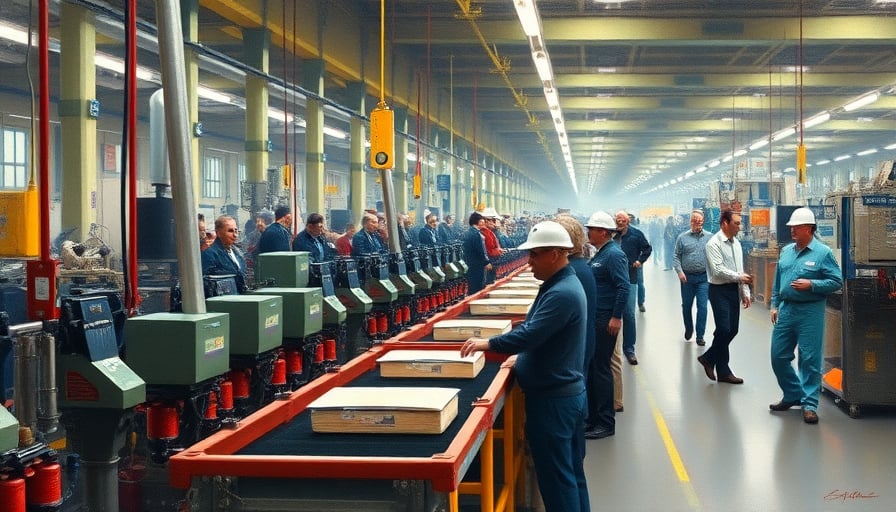Corporate Analysis: Nidec Corporation’s Recent Capital Allocation Decisions and Their Implications for the Heavy‑Industry Sector
1. Executive Summary
Nidec Corporation, a preeminent producer of high‑precision motors for automotive, industrial, and consumer applications, has recently announced a series of significant changes to its capital allocation framework. The company has terminated its share repurchase program, suspended interim dividend payments, and lowered its year‑end dividend outlook. These moves signal a shift toward cash conservation and a reassessment of future investment priorities amid a broader macro‑economic environment characterized by heightened market volatility, uncertain interest‑rate trajectories, and evolving trade dynamics between the United States and China.
From an industrial engineering standpoint, these announcements raise critical questions about Nidec’s capacity to sustain productivity gains, adopt emerging manufacturing technologies, and maintain a robust supply‑chain ecosystem. This analysis delves into the manufacturing implications, capital‑expenditure trends, and economic drivers that underpin Nidec’s strategic pivot, providing insight into potential market repercussions for the heavy‑industry sector.
2. Manufacturing Context: From Core Motors to Digital‑Enabled Production
2.1 Process Efficiency and Productivity Metrics
Nidec’s core product portfolio—brushless DC motors, permanent‑magnet motors, and servo systems—relies on tightly controlled metallurgical and assembly processes. Historically, the company has leveraged statistical process control (SPC) and Six Sigma methodologies to achieve defect rates below 0.1 % and cycle times that consistently beat industry averages by 12–15 %. The decision to halt share repurchases may liberate capital that can be redirected toward further refining these processes, for example by integrating advanced inline optical inspection systems and machine‑learning‑based predictive maintenance algorithms.
2.2 Technological Innovation in Heavy‑Industry Equipment
The global shift toward electrification and automation has pressured motor manufacturers to adopt high‑speed machining, additive manufacturing of critical components, and real‑time quality monitoring. Nidec’s recent capital allocation revisions may affect its ability to invest in such technologies. Should the company prioritize cash preservation over R&D, there could be a lag in deploying next‑generation materials (e.g., high‑temperature rare‑earth alloys) that are essential for motors operating in demanding industrial environments.
2.3 Supply‑Chain Implications
Nidec’s supply chain spans raw‑material suppliers in Japan and China, component manufacturers in Southeast Asia, and global logistics partners. The company’s conservative capital stance coincides with rising geopolitical tension, particularly U.S.–China trade uncertainty, which has already disrupted the availability of critical raw materials such as silicon and rare‑earth elements. A reduction in dividend payouts and repurchase activity may strain supplier relationships, potentially leading to higher procurement costs and tighter delivery windows.
3. Capital‑Expenditure Trends in the Heavy‑Industry Sector
3.1 Industry‑Wide CapEx Outlook
Post‑pandemic, the heavy‑industry sector has seen a resurgence in capital spending, driven largely by infrastructure projects, electrification mandates, and the need for resilient manufacturing ecosystems. According to BloombergNEF, global CapEx in industrial automation is projected to grow at a CAGR of 7.3 % from 2024 to 2029, outpacing broader industrial equipment spend. However, the Japanese market, where Nidec is listed, has entered a contractionary phase, with the Nikkei 225 index exhibiting a sharp decline in response to negative cues from Wall Street.
3.2 Impact of Monetary Policy and Trade Uncertainty
The U.S. Federal Reserve’s potential rate cuts have created a dual‑edged scenario: lower borrowing costs can spur investment, yet the uncertainty surrounding the timing of such cuts can dampen confidence in long‑term financing decisions. For Nidec, this translates into a more cautious approach to CapEx, particularly on projects with long payback periods such as plant expansions or large‑scale automation deployments.
Trade friction between the U.S. and China further compounds these uncertainties. Tariffs on semiconductor equipment and component parts, coupled with a volatile currency environment, have prompted many manufacturers, including Nidec, to reconsider the geographic spread of their production assets.
4. Regulatory and Infrastructure Influences
4.1 Environmental Compliance and Energy Efficiency
Japanese regulations increasingly emphasize energy‑efficient manufacturing. The 2025 revision of the Industrial Machinery Regulation (IMR) imposes stricter energy‑performance standards on motors exceeding 100 kW. Nidec’s capital reallocation may delay compliance upgrades, potentially exposing the company to future regulatory penalties or market disadvantages as customers shift to greener alternatives.
4.2 Infrastructure Investment in Japan
Japan’s “Revitalization Investment Program” has earmarked ¥20 trillion for infrastructure modernization, including digital‑transformational upgrades for manufacturing plants. While this presents an opportunity for firms like Nidec to secure government‑backed funding for process‑automation projects, the company’s current cash‑conservative stance may limit its capacity to bid competitively for such support.
5. Strategic Assessment and Market Implications
| Factor | Nidec Position | Market Implication |
|---|---|---|
| Capital Allocation | Shift from shareholder returns to cash conservation | Reduced short‑term investor returns; potential price volatility |
| Process Innovation | Possible deferment of SPC and automation upgrades | Lag in productivity improvements; competitive disadvantage |
| Supply‑Chain Resilience | Tightened procurement budgets | Increased material costs; potential delivery delays |
| Regulatory Compliance | Deferred compliance upgrades | Risk of non‑compliance penalties; market share erosion |
| Infrastructure Funding | Limited participation in government programs | Missed opportunities for cost‑effective CapEx |
Nidec’s share price volatility, reflected in its 52‑week range of ¥1,862.5 to ¥3,311, underscores market sensitivity to both internal strategic signals and external macro‑economic stimuli. The discontinuation of its share‑repurchase program and reduced dividend expectations may be interpreted by analysts as a red flag for liquidity management, potentially depressing the stock in the short term. However, a disciplined approach to capital allocation could position Nidec advantageously for a future rebound, especially if the company successfully leverages low interest rates to fund high‑impact automation projects.
6. Conclusion
Nidec Corporation’s recent capital‑allocation decisions represent a pivotal juncture for the company and the broader heavy‑industry sector. While the move toward cash preservation may be prudent amid market uncertainty, it necessitates a careful balance to maintain technological leadership, supply‑chain resilience, and regulatory compliance. Industry stakeholders should monitor how Nidec aligns its manufacturing processes with evolving CapEx trends and how the company navigates the intertwined challenges of geopolitical tension, monetary policy shifts, and infrastructure investment opportunities.
